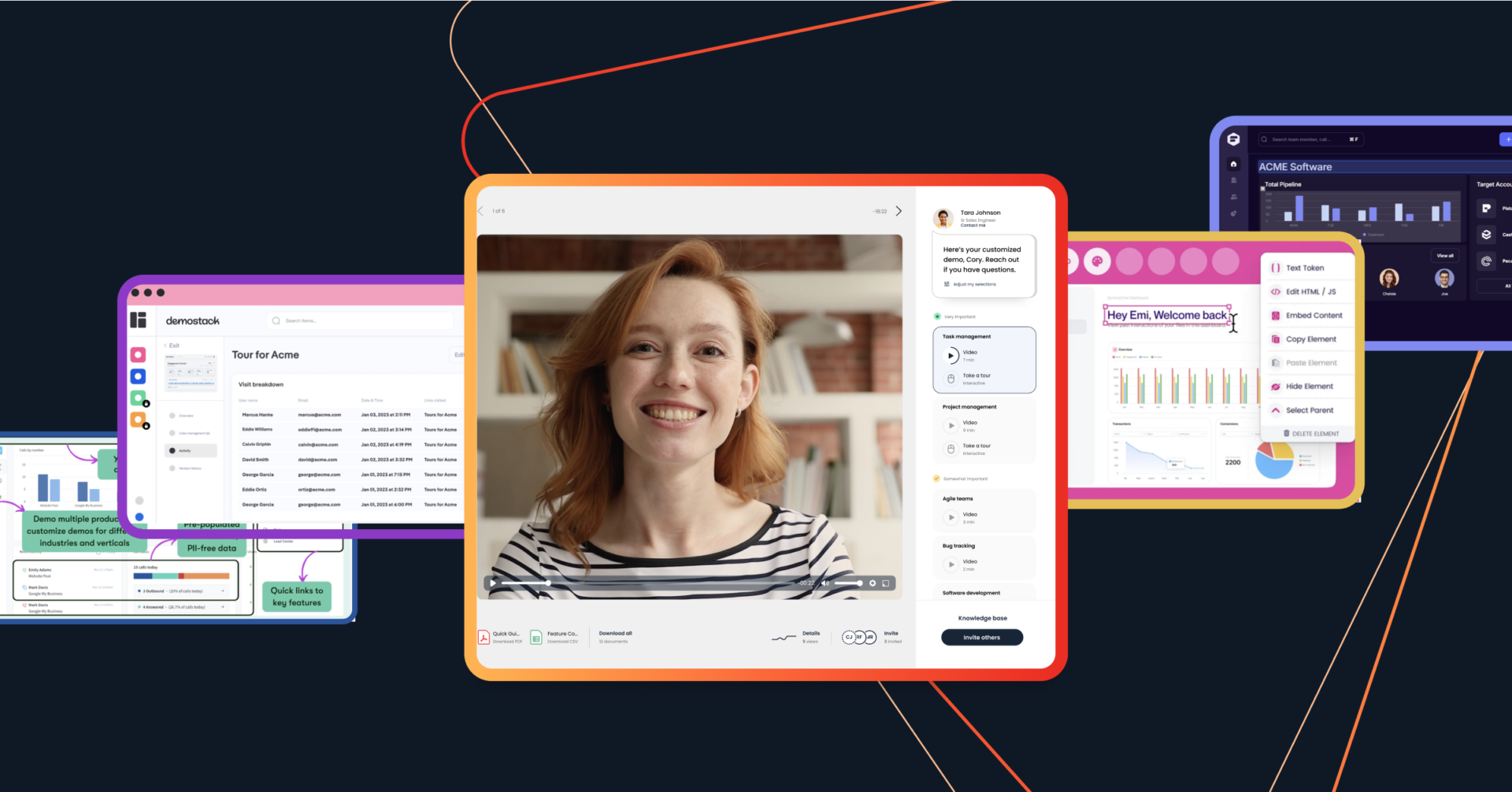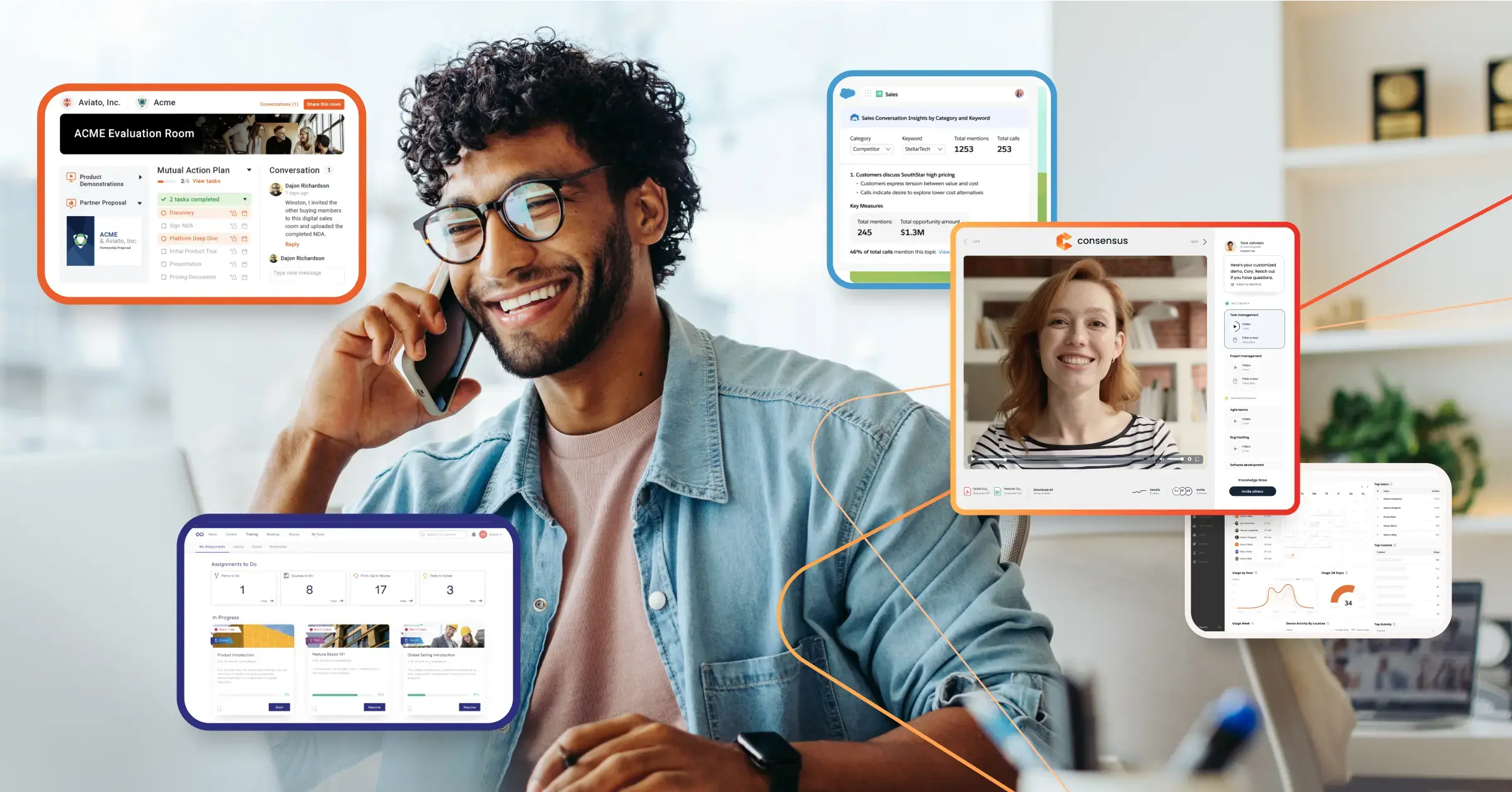
Melissa Megginson Axtell
Melissa Megginson Axtell
Close more deals with
Demo Automation.
Watch a Demo
Most enterprise buyers don’t want to talk to a sales rep—at least not right away. But that doesn’t mean they’ll settle for a generic, one-size-fits-all experience. In fact, over 50% of B2B buyers expect a high or very high level of personalization. And with buying cycles stretching nearly a year and involving up to 10 decision makers, buyers aren’t just looking for product info—they’re looking for clarity, consensus, and confidence.
Traditionally, sales teams have leaned on proof of concept (POC) programs to provide that confidence. POCs offer a way for buyers to test-drive your solution in a real-world setting, validate technical fit, and get internal alignment across a complex buying committee. Businesses that master sales POCs are 34% more likely to close deals faster and achieve higher win rates.
But, while POCs can be powerful, they also tend to be resource-intensive, time-consuming, and difficult to scale—especially when you're juggling multiple enterprise deals at once.
That’s why leading teams are turning to product simulations and guided demo experiences as a smarter, more scalable alternative. These experiences deliver the key benefits of a POC—like hands-on learning, technical validation, and stakeholder buy-in—without the manual lift or engineering bottlenecks. They empower buyers to explore your product on their terms, get the answers they need, and build internal consensus—long before your team ever steps into a live meeting.
In this guide, you’ll learn how to deliver POC-level value through interactive, on-demand product experiences—so you can engage technical buyers, accelerate decision-making, and win more enterprise deals with less effort.
What is a Sales Proof of Concept?
A sales proof of concept (POC) is a targeted, hands-on experience that lets buyers test your solution against their specific use cases before making a purchase. Unlike standard demos or limited free trials, POCs aim to prove that your product can deliver real results in a real-world scenario—bridging the gap between promise and proof.
But traditional POCs come with baggage.
They’re often time-consuming, resource-heavy, and hard to scale. Each one requires custom setup, close coordination with engineering or product teams, and weeks—sometimes months—of back-and-forth just to validate what your marketing materials already promised. And when you’re managing multiple enterprise opportunities or mid-market accounts simultaneously, this manual approach quickly becomes a bottleneck for both your sales engineers and your deals.
For complex B2B buying groups—where decisions are high-stakes and involve 6 to 10 stakeholders—POCs can still play an important role. But leading sales and presales teams are moving toward lighter, faster, and more scalable alternatives that deliver the same confidence-building experience, without the operational drag.
POC Software Alternative
Enter the automated product experience: a smarter alternative to the traditional sales POC.
With Consensus, you can deliver interactive product simulations that replicate key workflows, showcase technical value, and speak directly to each stakeholder’s role and priorities. These aren’t generic walkthroughs—they’re personalized, reusable, and trackable experiences that give buyers the clarity they need, fast.
Instead of spinning up custom environments, automated simulations use pre-configured templates and guided buyer journeys that mirror real product use cases tailored by industry, persona, or state in the buying process.
.png?width=640&height=508&name=Frame%204625%20(3).png)
Leading sales engineers are using them to amplify the impact of a tailored live demo. Start with a guided demo during your live meeting to establish context and walk through key workflows—then hand off a simulation so the buyer can explore the same value on their own time. This hybrid approach delivers the clarity of a demo and the credibility of hands-on testing is finally possible with a “light” POC experience.
Explore Consensus product simulations
Tailored POCs
Highly tailored POCs are customized experiences designed specifically for high-value enterprise accounts. They’re built around the buyer’s actual data, workflows, and business challenges, creating a realistic simulation of how your solution would perform after implementation.
These POCs involve significant effort from the sales engineering team. They involve configuring the environment, importing customer data, and designing test scenarios directly addressing the buyer’s most pressing pain points. Because of their resource-intensive nature, highly tailored POCs are usually reserved for late-stage opportunities with significant deal value.
When to Use a Sales POC (And When a Product Simulation Makes More Sense)
Sales proof of concepts (POCs) have long been used to give buyers a hands-on look at a product before they commit. But the truth is, most POCs are more hassle than they’re worth—especially in today’s fast-moving, multi-stakeholder sales cycles.
They’re time-consuming to set up, require deep involvement from technical teams, and often delay the sales process more than they help it. Even worse, many buyers expect a full POC before they’re truly qualified, draining your resources on deals that may never close.
And while a POC might seem like a good way to validate your product’s fit, it’s often a blunt instrument: hard to control, slow to deliver, and nearly impossible to scale.
Rather than defaulting to a traditional POC—or leaving prospects without a way to explore after a demo—modern revenue teams are using product simulations to extend the live demo experience and give buyers a hands-on way to validate your solution.
With Consensus, you can deploy interactive, guided product experiences that replicate real-world use cases, tailored to each buyer’s role, pain points, and industry. Simulations provide the hands-on validation buyers want—but in a format that’s faster to deliver, easier to personalize, and far more scalable than a full POC.
Here’s when a simulation is clearly the better choice:
- You need speed: Simulations can be launched in minutes, not weeks, so you don’t lose momentum in the sales process
- The deal doesn’t justify a full lift: For mid-market or smaller enterprise deals, a full POC is often overkill
- You’re working with multiple stakeholders: Simulations can be shared and viewed asynchronously, helping buying groups align without adding meetings
- Your presales team is stretched thin: Simulations let you scale technical validation without bottlenecking on sales engineering resources
- You need support with a technical, high-stakes deal: Simulations are often used to reinforce a live demo with a lightweight, self-guided proof experience that buying teams can explore internally.
- You want insight: Simulations are trackable, so you can see exactly what buyers engage with—and follow up with precision
Instead of hoping a POC will convince the buying committee, a product simulation shows each stakeholder exactly what they need to see, when they need to see it—no delays, no demos, no dead weight.
So while POCs still have their place in rare, highly technical deals, most buyers—and most sales teams—are better served with a more modern, scalable approach that combines live demos and simulations.
Sales POC Alternatives: Why Product Simulations Are a Better POC Experience
Successful product simulations follow a structured methodology that keeps buyers engaged, while clearly showcasing your solution's impact on their specific challenges.
1. Identify Prospect Challenges
Before creating your demo environment, conduct thorough discovery to identify the specific pain points and use cases that matter most to your buyer. POCs typically address 3-5 clearly defined challenges, rather than attempting to showcase every feature, so you’ll want to do the same. Document these challenges in a formal plan that both teams approve so everyone’s aligned on what success looks like.
This documentation should include specific metrics and sales efficiency KPIs your buyer wants to improve, current processes that need enhancement, and the business impact of solving these issues.
Involve key stakeholders from both technical and business teams in defining objectives. Some questions to ask your buyer might include:
- “What would a successful implementation look like in your environment?”
- “Which metrics would demonstrate meaningful improvement for your team?”
- “What specific workflows or processes are causing the most pain today?”
- “Who will be evaluating the results, and what matters most to them?”
2. Develop Your Sales Environment
In a traditional POC, building the right sales environment is one of the most time-consuming and resource-draining steps. You need to create a realistic, controlled space that mirrors your buyer’s business—complete with relevant data, configured workflows, and just enough customization to demonstrate value without breaking your product.
This usually requires close coordination between sales, presales, and engineering teams. That means weeks of back-and-forth, chasing down technical resources, manually inputting sample data, and documenting every detail so nothing gets lost in translation. And if you’re running multiple POCs? Multiply that pain across every opportunity.
Now imagine skipping all of that.
With Consensus, you can build and launch fully guided product simulations in a fraction of the time—no engineering required. AI-generated synthetic data lets you instantly tailor the experience to each buyer, with industry-specific language, use-case-focused flows, and role-based personalization built right in.
Instead of spinning up a separate environment for each opportunity, you can create one simulation that scales across hundreds of buyers—while still delivering a personalized, on-demand experience that feels like it was built just for them.
It’s fast. It’s repeatable. And it’s everything buyers need to evaluate your product—without the heavy lift of a traditional POC.

3. Enable Your Buyer
Grant your buyer access to the product environment once it’s ready to go, then move into guidance mode. Provide straightforward user guides and tutorials that give your buyer the freedom to explore the environment at a pace that works for them.
Every buyer’s learning curve is unique, so make sure your buyer enablement strategy reflects that. An effective strategy typically includes:
- Comprehensive documentation with screenshots and clear instructions
- Initial training sessions to orient users to the environment
- Regular check-ins to address questions and provide guidance
- A clear support process for technical issues or questions
- Reminders about key milestones and deadlines
Set clear expectations about the POC experience, including its duration, required involvement from their team, and what support you'll provide throughout the process.
4. Measure Results
Define specific, measurable success criteria before starting your product simulation to ensure objective evaluation of results. Collect both quantitative metrics (like performance improvements, time savings, or error reductions) and qualitative feedback from users about their experience. Document all learnings—both positive and negative—to inform your final proposal and improve future experiences with similar buyers.
5. Close On the Deal
Just because a buyer is impressed with your product doesn't guarantee they’ll sign on the dotted line. Now’s the time to highlight the contrast between their current situation and the improvements demonstrated during the simulation—leverage the results in your final negotiations by connecting the demonstrated value to their business objectives.
Be prepared to address any remaining objections or concerns with clarity and confidence. Establish a clear path to implementation that builds on the momentum from the proof of concept, including a timeline, resource requirements, and key milestones.
It’s also important to maintain engagement after the demo concludes by scheduling regular check-ins and providing additional sales resources that keep your solution top-of-mind during final decision-making.
Limitations of Traditional Sales Proof of Concepts
Traditional POCs come with some challenges to consider. Make sure to keep the following limitations in mind:
Can’t Be Used For All Products
Some products aren’t well-suited for traditional POCs. Solutions with extremely long time-to-value, such as enterprise-wide digital transformations or complex data analytics platforms, may not demonstrate meaningful results within typical POC timeframes.
In these cases, the limited POC window might actually undersell your solution's full potential.
Extensive Use of Resources
POCs demand planning, coordination, and resources from sales engineering teams. The problem? Most sales engineers are already stretched thin, supporting up to 10 account executives simultaneously while juggling multiple POCs.
And with the average enterprise buying committee now including 4-12 stakeholders, each with their own technical concerns, the time commitment required to create personalized POC experiences at scale can cause serious bottlenecks, especially for companies with limited presales capacity.
Fortunately, creating product simulations with Consensus is fast, intuitive, and doesn’t require dev support. All you have to do is navigate through your product and select the areas you want buyers to access and experience, then lock the data to ensure a stable environment. Using Consensus’ AI-Generated Synthetic Data Editor, you can automatically personalize the content to fit every buyer’s exact interests and needs.
Sharing your simulations is just as easy—generate custom links to send via email, social media, and anywhere else you engage with your customers. And with Demolytics, you can see how your buyers navigate your content to determine whether or not a POC is a good fit.
Benefits of Using a Sales POC Alternative
Traditional sales POCs can help validate your product, but they come at a steep cost—time, resources, and scalability. That’s why more high-performing revenue teams are shifting to product simulations as a smarter, more scalable alternative. You get the strategic advantages of a POC without the technical complexity or operational drag.
Here's how simulations outperform traditional POCs:
Helps Visualize the Functionality of the Product
Product simulations let buyers experience your solution solving their specific problems—without requiring access to their environment, live data, or a custom-built instance. Simulations are guided, interactive, and tailored to key personas, helping buyers connect the dots between your features and their real-world pain points. It’s the clarity and confidence of a POC, without the setup delays.
Builds Trust and Credibility
The psychological impact is the same: as buyers click through tailored scenarios that mirror their workflow, they start to see themselves using your product. That emotional investment—the feeling of “this is built for me”—drives stronger engagement and increases the likelihood of purchase. And because simulations are easily shareable, you empower internal champions to spread that conviction across the entire buying committee.
Allows for Real-Time Customer Feedback
Just like a POC, product simulations create an opportunity for real-time feedback—but in a far more efficient format. As buyers interact with specific features, you capture engagement data, uncover objections early, and get a clearer picture of what each stakeholder cares about most. That insight helps refine your sales strategy and allows you to proactively address concerns before they stall the deal.
The best part? All of this happens without involving engineering, spinning up environments, or tying up your presales team for weeks. With Consensus, you can create personalized, scalable product experiences that deliver the confidence buyers need to move forward—faster.
Support Your Sales Engineers With an Experience Even Better Than a Sales POC
While 70% of purchase decisions are influenced by hands-on product experiences, traditional POCs are often too slow, too technical, and too resource-intensive to keep up with modern B2B sales cycles. Sales engineers are spending weeks configuring environments, coordinating with IT, and customizing demos—often for buyers who aren't yet committed.
Consensus gives sales engineers a better way to deliver proof—without the overhead of traditional POCs.
By combining the sales storytelling and personalization of a POC with the speed and scale of automation, Consensus empowers presales teams to deliver powerful, hands-on product experiences that build confidence and accelerate decision-making—all while freeing up valuable SE time.
Automated product simulations let prospects engage with your product through guided, interactive walkthroughs that mirror real workflows and use cases. There’s no engineering support needed, and no waiting around. In seconds, buyers get a data-rich, immersive experience that can be explored on a live demo or at their own pace.
With built-in engagement analytics, sales engineers get visibility into exactly how prospects interact with the content—what they clicked, what they rewatched, what they skipped—so follow-ups can be highly targeted and deal cycles can move faster.

.webp)


